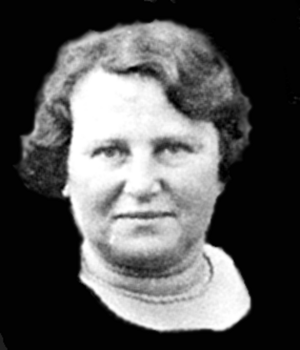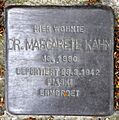Margarethe Kahn facts for kids
Quick facts for kids
Margarethe Kahn
|
|
|---|---|
 |
|
| Born | 27 August 1880 Eschwege, German Empire
|
| Died | 28 March 1942 (aged 61) (deported to Piaski on this date, and missing since then) Piaski, Poland
|
| Nationality | German |
| Alma mater | University of Göttingen |
| Scientific career | |
| Fields | Mathematics (algebraic geometry) |
| Thesis | Eine allgemeine Methode zur Untersuchung der Gestalten algebraischer Kurven [A general method for the study of the forms of algebraic curves] (1909) |
| Doctoral advisor | David Hilbert |
| Other academic advisors | Felix Klein |
Margarethe Kahn (also known as Grete Kahn, born August 27, 1880) was a German mathematician. She was one of the first women in Germany to earn a doctorate degree. Sadly, she went missing after being sent to Piaski, Poland, on March 28, 1942. Her important work was about the shapes of algebraic curves.
Contents
Early Life and Education
Margarethe Kahn was born in Eschwege, Germany. Her father, Albert Kahn, owned a flannel factory. She had an older brother named Otto. After her mother passed away, her father married her aunt, and Margarethe gained a half-sister, Martha.
Schooling Challenges for Girls
From 1887, Margarethe attended elementary school. Then, from 1889 to 1896, she went to the Higher School for Girls. At that time, it was very hard for girls in Germany to get a good high school education. There were not many high schools for girls. Because of this, Margarethe took private lessons until 1904. These lessons helped her prepare for her Abitur. The Abitur is like a final exam that allows you to go to university.
In 1904, Margarethe was allowed to take her Abitur at a boys' high school in Bad Hersfeld. This was a big deal! She was one of the few young women in Germany at the start of the 20th century who could take this important exam. A famous person named Konrad Duden, who created a well-known German dictionary, signed her Abitur certificate.
University Studies
Women were not officially allowed to attend universities in Prussia until late 1908. So, Margarethe and her friend Klara Löbenstein first attended the University of Berlin and University of Göttingen as guest students. This meant they could attend classes but were not fully enrolled.
They studied mathematics and physics. Margarethe also went to lectures at the Technical University of Berlin. At Göttingen, she learned from famous professors like David Hilbert and Felix Klein. Her special area of study was algebraic geometry. This field looks at geometric shapes that can be described by mathematical equations.
Important Mathematical Work
Margarethe Kahn and Klara Löbenstein worked together on a very complex math problem. It was part of something called "Hilbert's sixteenth problem." This problem was about understanding the shapes of algebraic curves. Specifically, it asked if certain complex curves could have a specific number of separate oval shapes. Kahn and Löbenstein developed new ways to study these shapes.
Earning a Doctorate Degree
Despite some opposition, especially from professors in Berlin, Margarethe Kahn earned her doctorate in 1909. She studied under Professor David Hilbert at the University of Göttingen. Her dissertation, which is a long research paper, was titled Eine allgemeine Methode zur Untersuchung der Gestalten algebraischer Kurven. This means "A general method to investigate the shapes of algebraic curves."
Because of this, Margarethe Kahn became one of the first German women to earn a doctorate in mathematics. She took her final oral exam on June 30, 1909, along with her friend Klara Löbenstein.
Career and Later Life
After getting her doctorate, Margarethe Kahn could not become a university professor. At that time, women in Germany were not allowed to become professors until 1920. So, she decided to become a schoolteacher instead.
In 1912, she started working as a teacher in the Prussian school system. She taught at secondary schools in different cities, including Katowice and Dortmund. From 1929, she taught in Berlin-Tegel and later in Berlin-Pankow.
Persecution and Disappearance
Margarethe Kahn was Jewish. When the Nazis came to power in Germany, they began to persecute Jewish people. In 1933, she was forced to take a leave from her teaching job. By 1936, she was completely dismissed from the school.
She was then forced to work in a factory that made snow chains. On March 28, 1942, Margarethe Kahn and her widowed sister Martha were sent away to Piaski. They have been missing ever since.
Legacy and Remembrance
People remember Margarethe Kahn today.
- On September 13, 2008, a special memorial stone called a Stolperstein was placed in Berlin. It is at 127 Rudolstädter Straße and remembers Margarethe Kahn.
- Another Stolperstein was laid on May 26, 2010, in front of her parents' old house in Eschwege. A special plaque was also put there on December 13, 2017.
- In 2013, a street in Leverkusen was named after her.
Images for kids
-
Stolperstein at 127 Rudolstädter Straße in Wilmersdorf, in memory of Margarethe Kahn


